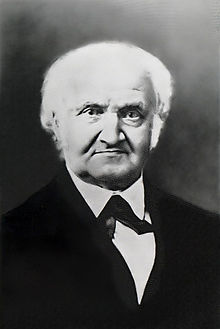Eduard Heis

Eduard Heis (18 February 1806, Cologne – 30 June 1877 in Münster) was a German mathematician and astronomer.
He completed his education at the University of Bonn in 1827, then taught mathematics at a school in Cologne. In 1832 he taught at Aachen, and remained there until 1852. He was then appointed by King Frederick William IV to a chair position at the Academy of Münster in 1852. In 1869 he became rector of the Academy.
While at the academy he made a series of observations of the night sky, including the Milky Way, zodiacal light, stars, and shooting stars. These were published in the following works, among others:
- Atlas Coelestis Novus, Cologne, 1872.
- Zodiakal-Beobachtungen.
- Sternschnuppen-Beobachtungen.
- De Magnitudine, 1852.
His star atlas, which was based on Argelander's Uranometria Nova (1843), helped define the constellation borders in the northern sky. His other publications included a treatise on the eclipses during the Peloponnesian war, Halley's comet, and some mathematical text books.
He was also the first person to record a count of the Perseid meteor shower in 1839, giving an hourly rate of 160. Observers have recorded the hourly count every year since that time.
Awards and honors[]
- Order of the Red Eagle, 1870.
- Awarded doctor honoris causa by Bonn University, 1852.
- Foreign associate, Royal Astronomical Society of London, 1874.
- Honorary member, Leopoldine Academy, 1877.
- Honorary member, Scientific Society of Brussels, 1877.
- The crater Heis on the Moon is named after him.
External links[]
| Wikisource has the text of a 1905 New International Encyclopedia article about "Eduard Heis". |
- J. G. Hagen (1913). . In Herbermann, Charles (ed.). Catholic Encyclopedia. New York: Robert Appleton Company.
- Atlas Coelestis Eclipticus, Coloniae ad Rhenum, 1878 da www.atlascoelestis.com
- 1806 births
- 1877 deaths
- 19th-century German astronomers
- German Roman Catholics
- 19th-century German mathematicians
- Scientists from Cologne
- People from the Rhine Province
- University of Bonn alumni
- University of Münster faculty